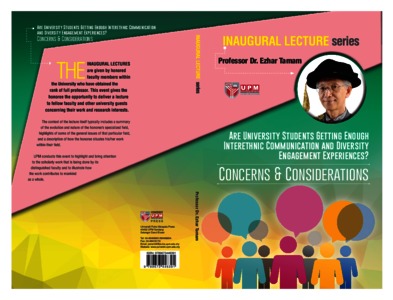Citation
Tamam, Ezhar
(2016)
Are university students getting enough interethnic communication and diversity engagement experience?: concerns & considerations.
[Inaugural Lecture]
Abstract
Interethnic communication study in today’s increasingly democratic multicultural societies is important to improve communication practices and relations across ethnic boundaries. Within the context of higher education settings, interethnic contact, attention to news in the media and other forms of culture-related diversity engagement are important because they contribute to social and personal development. Positive interethnic contact in different communication settings, intercultural communication sensitivity, interethnic bridging social capital and attachment to the national ethos are salient social processes and mechanisms within students’ development and unity-integration frameworks. This monograph highlights concerns and considerations related to undergraduates’ interethnic communication and culture-related diversity engagement, and the implications for academicians and administrators.
Although interethnic/intergroup posturing is not pronounced, Malaysian undergraduates are not extensively engaged in interethnic interaction and socialization despite their awareness of the importance of such engagement and the continuous call for them to mingle on a regular basis. Interethnic interaction and socialization on a daily basis are not yet a norm in the lives of local students. Such engagements occur more often in structured or facilitated situations and mostly on matters related to academic activities. The undergraduates are also found to have little interest in news in the news media, although the news media has a role in the development of social attitudes. It also seems to be a norm for undergraduates not to capitalize on the wide ranging diversity-related learning opportunities that are presumably available to them throughout their three- to four-year study period. Intercultural sensitivity, interethnic bridging social capital and civic responsibility development among undergraduates are affected by the extent to which they experience positive interethnic interaction and socialization, in and outside the classroom. Thus interethnic contact and diversity learning experiences, where relevant and appropriate, should be systematically and strategically integrated into the students’ study program. It is necessary to develop positive interethnic contact expectations that members of other ethnic groups have an interest to interact with members of one’s own ethnic group. This has to be emphasized and integrated in the formal curriculum (in the teaching of intercultural communication or in courses related to cultural diversity and ethnic relations in particular) and in cocurriculum activities. For the contact to have positive effects it must be under conditions that are conducive. These conditions are: (1) equal group status within the situation; (2) common goals; (3) intergroup cooperation; and (4) authority support. Students must perceive and feel that the campus multicultural environment promotes inclusiveness, where the students feel that the different ethnic groups are of equal status and working for common goals in a cooperative manner and policies for better intercultural relations are in place and endorsed by the university.
Additionally, as the news media has a role in fostering interethnic tolerance, attachment to national ethos and national pride, the news media must convey more positive news on national affairs and interethnic relations to enhance unity and intercultural understanding. Such news should then be strategically tapped as learning resources.
On the more specific goal of nation building, within the context of higher education systematic longitudinal studies, including assessment studies, are recommended. Individual- and institutional-level factors that facilitate and hinder a higher level of positive ethnic/culture-related diversity engagement in and outside classrooms must be integrated in future studies.
Download File
![[img]](http://psasir.upm.edu.my/58813/1.hassmallThumbnailVersion/20170731173927ARE_UNIVERSITY_STUDENTS_GETTING_ENOUGH_INTERETHNIC_COMMUNICATION_AND_DIVERSITY_ENGAGEMENT_EXPERIENCES_CONCERNS_%26_CONSIDERATIONS__.pdf)  Preview |
|
Text
20170731173927ARE_UNIVERSITY_STUDENTS_GETTING_ENOUGH_INTERETHNIC_COMMUNICATION_AND_DIVERSITY_ENGAGEMENT_EXPERIENCES_CONCERNS_&_CONSIDERATIONS__.pdf
Download (2MB)
| Preview
|
|
Additional Metadata
Actions (login required)
 |
View Item |

